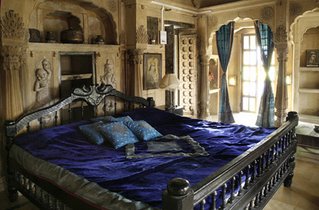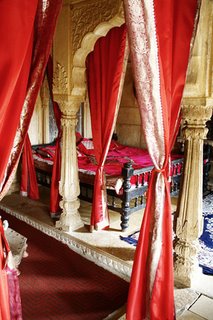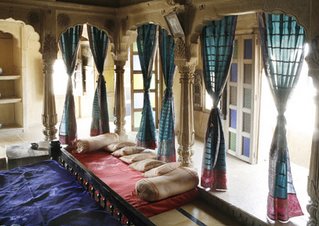The Golden Fort of Jaisalmer was founded in 1156 AD by Rawal jaisal and creates an illusion of growing out of a rock in an undulating sea of sand. It is the second oldest fort of Rajasthan, Walking up into the Fort is one of life’s great joys. Four huge carved gateways lead into Dussehra Chowk, the central square where the Maharaja presides over certain festivals. The First Gate has two round towers supporting it, and above the gateway a delightful mudmirrored room is converted into a restaurant, Little Italy, where you can watch everyone entering or leaving the fort. The Second and Third Gates are at 180 degrees to each other and joined by a small but steep section of paved road, flanked by overpowering walls formed of large blocks of golden sandstone, built without aid of cement or mortar. One can imagine the raiders being repulsed! Vast wooden doors on the gates have spikes to repel elephants, and until recent times were closed every night. A more gentle slope leads to the top gate which is actually a bridge joining two section of the Palace. This gateway is more than twenty metres high, a wonderful entrance to the Fort. Inside this narrow gateway, the side benches of golden sandstone are polished to a mirror from over eight hundred years of use. Beside the benches are indentations in the stone for a variety of games. A cool breeze is always found here – so picture the inhabitants sitting here over hundreds of years, playing games to while away the hot afternoons.
Inside the Fort over five thousand people live, and most of them work here too. The houses are traditional and usually over three floors, housing the same families for many generations. The lanes and streets are narrow, the balconies above so housewives can chat to each other across the busy passersby below. Shops selling embroidered bedcovers, delicate silver items, old wooden toys, modern light cotton clothes all share space with the chai seller, small shops offering cool drinks and fruit juices, cafes and restaurants, and of course over twenty five temples from the elaborate Jain heritage temples to simple corner shrines. Sacred cows and motor bikes share the lanes with brightly saree clad women, lots of energetic children, priests, traders, tourists, guides and local inhabitants. The only form of transport once inside the narrow lanes is the motor bike, used to carry goods to the hotels and shops, to take children to school and women to the market.
The fort seems a maze in which to get lost, but one soon discovers it is a small place where one can know nooks and crannies, and the artist painting and selling his beautiful goods knows you by your second day. One does not need a map in the fort, just a healthy appetite for the cups of Indian masala chai you will be offered. There is so much to see and do in the Fort. One can visit the Palaces, inspect the repairs being carried out in a traditional manner, see the cannons and enjoy sunset from the Fort walls, spend hours appreciating the ancient Jain temples and their carvings that rival anything in India, join in the prayers and singing in the Hindu temples, sit, look and learn about the various handicrafts for which Jaisalmer is famous: or maybe best of all, just wander around, talking to the inhabitants, and enjoy this wonderful Fort, one of the very few in which people live.
Access to all the View Points in Jaisalmer -
Jain templeMaharajah’s PalaceSurya TempleLaxminath TempleRaj
Hotel Shreenath palace
On fort jaisalmer
.jpg)








